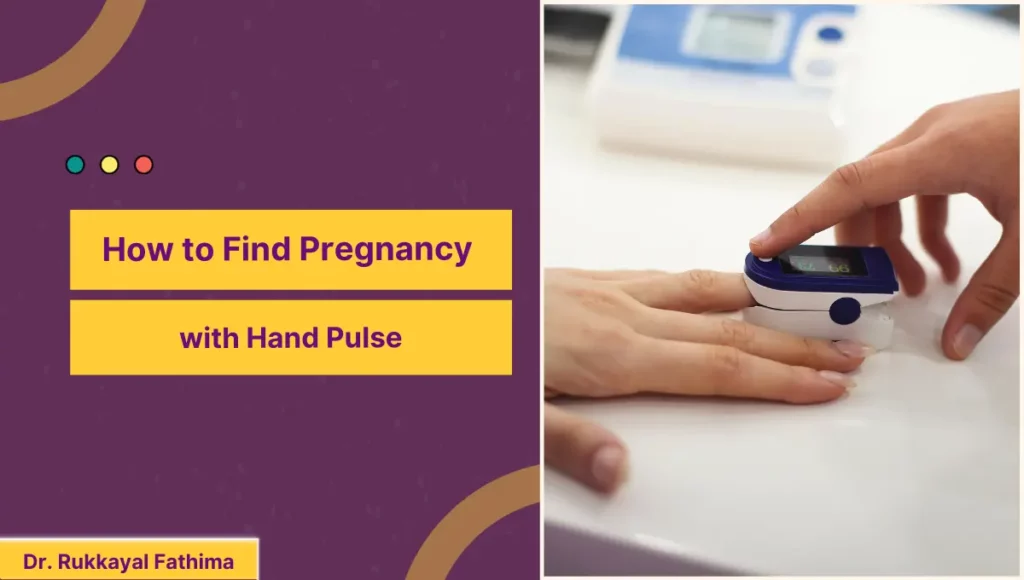There are many methods to find out whether you are pregnant. Some women buy a pregnancy kit, and some visit their doctors for a blood test or ultrasound scan.
One such method to identify pregnancy is the hand pulse method. This is a traditional method that has been followed for centuries by various cultures to diagnose pregnancy in women.
But how exactly does it work? How do you identify the difference between a normal pulse and a pregnancy pulse? Let’s dig deeper and understand how to find pregnancy with hand pulse for a women.
Can we find pregnancy by pulse?
Though pulse rate can indicate pregnancy, it is not a very reliable method. So, no, you can’t confirm pregnancy through a hand pulse alone. Sometimes, a woman may be pregnant but have no changes in her heart rate. Moreover, the accuracy of the method depends upon the doctor’s expertise.
If you suspect you are pregnant, do a pregnancy test or visit an experienced professional to confirm your pregnancy.
How does your pulse feel when you are pregnant?
The main characteristic of pulse during pregnancy is the increase in heart rate. Some women may experience heart palpitations (fast-beating or pounding heart).
This palpitation is mainly because of the increased amount of blood your heart has to pump. During pregnancy, the amount of blood increases, making it harder for the heart to pump them throughout the body and the fetus.
Thus, your heart has to put in extra work to pump the blood, which might feel like your heart is beating faster than normal. This increased workload can cause palpitations. However, they are usually harmless and should go away after the baby is born.
Is a pregnant woman’s pulse higher?
Yes, your pulse will be higher during pregnancy. As we saw above, the amount of blood in the body increases during pregnancy. This is to facilitate blood flow to the fetus and nourish its growth.
The heart has to beat faster and harder to pump all that blood throughout the body. Thus, a pregnant woman’s pulse might be higher than normal. This will become normal after childbirth.
how to check pregnancy with hand pulse?

There are four ways you can check your pulse during pregnancy. Each method is associated with an artery running through a particular body part. Now, let’s look into each method in detail.
The radial pulse method
The radical pulse method is done by measuring the number of beats per minute through the radial artery. Here is how you can take a pregnancy pulse through the radial artery.
- First, you need to locate your radial artery. This artery can be found on the inner side of your wrist just below your thumb.
- Place your index and middle fingers on your wrist and move them till you feel the pulse.
- Count the number of beats you get for 15 seconds.
- To get your count per minute, multiply the count by 4.
- For example, if you get 22 beats in 15 seconds, then your pulse is 88 beats per minute.
Note: Don’t use your thumb to measure your pulse. An artery passes through your thumb, so it might confuse the count. |
The carotid pulse method
The carotid pulse is taken by counting the number of beats per minute through the carotid artery that runs through your neck. Here’s how to do it.
- Locate the carotid artery by placing your index and middle fingers on your neck. This artery can be just below your jawline near your windpipe.
- Move your finger along the neck till you feel the pulse.
- Count the number of beats you get for 15 seconds.
- Multiply it by 4 to get your beats per minute.
The pedal pulse method
You must know where to measure this pulse from the word “pedal.” This pulse can be taken from the dorsalis pedis artery that runs through the bone above your feet.
- Place your index and middle fingers on the bone that runs along the top of your foot.
- Move your fingers until you feel your pulse. (It might be difficult to find the pulse on your foot. If one leg doesn’t work, switch to the other leg.)
- Once you feel the pulse, count it for about 15 seconds.
- Multiply the count by 4 to get your beat per minute.
The Brachial pulse method
This method involves checking your pulse using the brachial artery that runs through your arm. Here’s how you can measure your pulse through the brachial artery.
- Find your brachial artery. It is located on the inner side of your elbow.
- Place your index and middle fingers on your elbow and move them until you feel the pulse.
- Count the beats for about 15 seconds and multiply by 4 to get your beats per minute.
How to Check Pregnancy Pulse in Neck

The idea of a “pregnancy pulse” in the neck as a method to diagnose pregnancy does not have a scientific foundation. There’s no medically recognized or reliable way to confirm pregnancy based on pulse detection in the neck. Instead, pregnancy is typically confirmed through specific and reliable methods:
Home Pregnancy Tests
These tests detect the presence of the hormone hCG (human chorionic gonadotropin) in urine. They’re widely available and can provide results quickly after a missed period.
Blood Tests
Conducted by a healthcare provider, blood tests can detect pregnancy earlier than urine tests by measuring the exact amount of hCG in the bloodstream.
Conclusion
A hand pulse is a good way to identify your pregnancy. But know that it requires experience to accurately determine if the changes in the heartbeats are due to pregnancy or other health conditions.
A hand pulse is not a surefire way to confirm your pregnancy. If you think you are pregnant, it is best to take a pregnancy test or visit your Obstetrician for confirmation.
Your heart rate may increase, decrease, or skip a beat during pregnancy. Heart palpitations are quite prevalent during pregnancy. The blood volume in your body increases substantially during pregnancy, making it harder for the heart to pump them.
Yes, it is quite common for pregnant women to have a high pulse rate. This is mainly due to the increased blood in the body that the heart needs to pump to support the health of the mother and fetus.
A pregnancy test is the best way to test your pregnancy at home. Go to your nearest medical store and buy a pregnancy kit. It will help determine your pregnancy by measuring the hCG levels in your urine.





